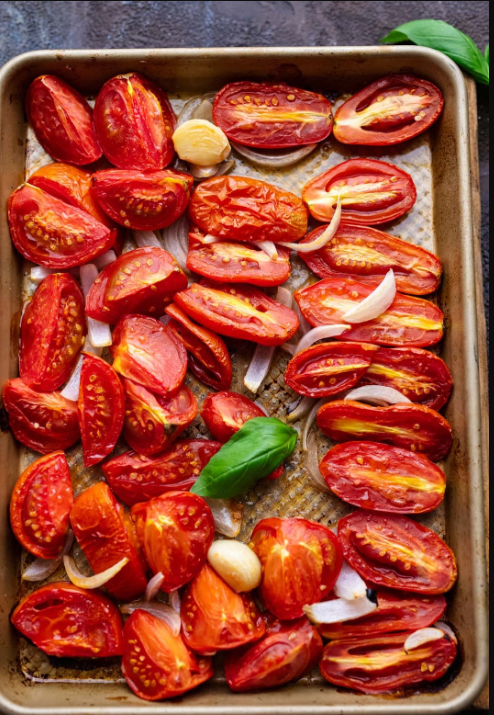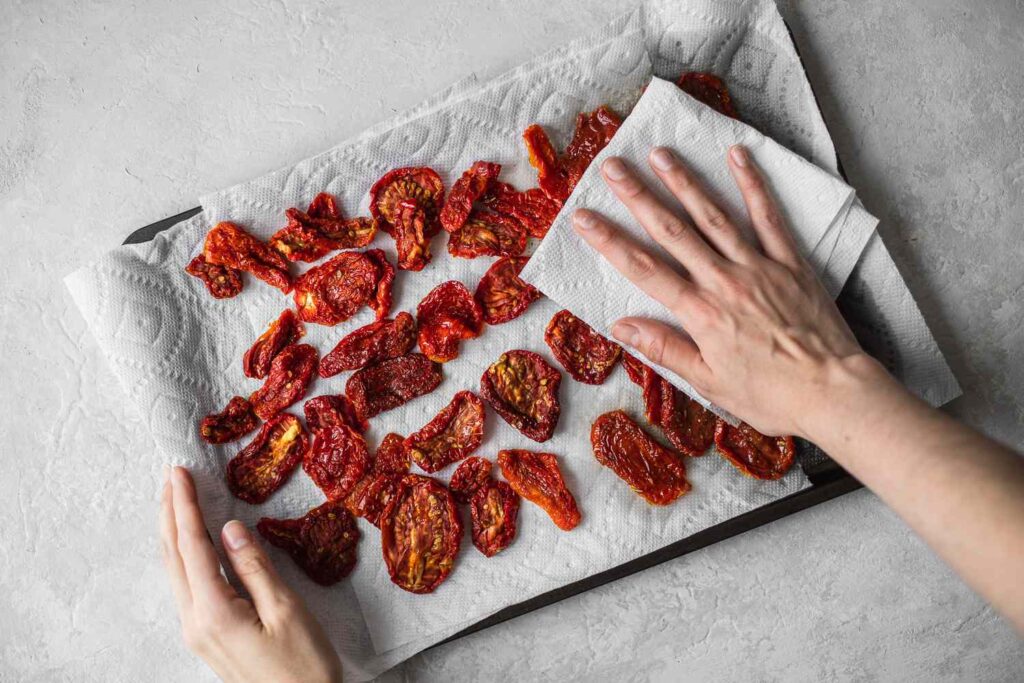In addition to having a particular flavor, the tomato sheet is one of the essential ingredients for soups or sauces and can even be used as a snack. Go with the rest of the article to get acquainted with the introduction of the tomato sheet.
Step 1: tomato preparation
Also, hygiene is essential for dry tomatoes. So, the following is the way of preparing tomatoes.
1) Select several ripe tomatoes to prepare the tomato leaf
Select several ripe tomatoes without crushed or discolored parts to prepare the tomato leaf.
Hard, fleshy tomatoes are good options for drying. They dry faster than other types of tomatoes.
To dry, choose ripe tomatoes, or aseptic tomato paste but be careful not to pick overripe ones.
Juicy tomatoes are not a good choice for drying because they contain a lot of liquid.
2) Peel a tomato, grate it, and squeeze the juice.
If you are not interested in tomato skin, you can get a skinless tomato leaf with this extra step. To begin peeling, make a small X in the skin of the tomatoes with a knife to peel them more easily. Or You can use the tomato puree- Arenafood is a tomato puree manufacturer.
Bring the water to a boil in a medium bowl, immerse the tomatoes in the boiling water, and simmer for 30-45 seconds.
Now, pour the tomatoes into a bowl of ice water to reduce the temperature quickly. This process only involves cooking the skin of the tomato so that somebody can peel it quickly and without affecting its texture.
Next, start peeling the tomatoes. To make this step more accessible, you should begin peeling from the place of the mark you made earlier. But if you do not find those places, do not worry, because cooking the skins of tomatoes has prepared them to peel.
3) Cut the tomatoes in half
Depending on the size of the tomato, you can easily cut them in half, or even if you have larger tomatoes, you can divide them into four parts. Tomatoes may look large at this stage, but a tomato leaf made by drying half a tomato will not be much larger than a small spoon.

4) Peel parts of the tomato that are discolored or hard
Remove the white slice of the tomato that connects the stem. Also, if you want to separate the tomato seeds, do so at this stage. Fleshy tomatoes have fewer seeds and are better options for preparing tomato leaves.
Step 2: Dry the tomatoes
Dry tomatoes are very delicious, and all kinds of people like them.
1) Place the tomatoes on a surface to absorb the water
Please do not press them together; spread them evenly on the surface so they are dry entirely and simultaneously.
2) Add the necessary spices to the tomatoes
You can use any spice to flavor the tomatoes, but a little salt and pepper are usually acceptable.
Remember that the volume of tomatoes decreases significantly after drying, so the taste of the added spices is intense, so be careful when adding spices, especially salt.
Basil and mint are also good spices for dried tomatoes.
By adding a small amount of sugar, you can give a sweet taste to the tomato leaf. Drying some types of tomatoes can make them a little bitter, so by adding a few tablespoons of sugar to the tomato, you can be sure that after drying, Fresh varieties are tasty and a little sweet.

3) Use a food dryer
The easiest way to make tomato leaves is to use a food dryer. Some models even have a specific setting for drying tomatoes that sets the machine to the desired temperature for drying tomatoes.
Follow your dryer instructions and check the tomatoes occasionally to ensure they are not too dry and do not burn.
4) Use the oven
Set the oven to its lowest temperature. If you use the stove to prepare the tomato leaves, it is possible to over-dry the tomatoes, so set the oven temperature to 65 ° C so that the tomatoes just dry and the oven does not burn them.
Use baking trays and bread trays. It takes 12 to 24 hours to complete the drying process, and you should check the tomatoes periodically to ensure they are not burned.
Turn the tomatoes upside down to ensure that both sides are evenly dried. If your oven does not transfer heat evenly, change trays or tomatoes regularly to ensure they dry evenly and simultaneously.
5) Use the sun to dry the tomatoes
If you live where the weather is mostly warm and sunny throughout the year, you can use the sun to prepare tomato leaves.
Place the tomatoes on a baking tray, season them, and then place the tray in direct sunlight. To prevent dust or insects from settling on the tomatoes, cover them with a thin cloth or paper towel and bring the tray into the house when the air cools. It may take a long time (more than 48 hours), but the important thing is that you will not use any energy for this drying type.
Drying tomatoes by sunlight and heat has always been a popular technique.
6) Remove the tomatoes from the heat before they are scorched
Drying of tomatoes is completed when they are slightly curved and have a reddish-garlic-like texture. They should look more like a raisin than a dried and somewhat sticky pepper.

Step 3: Store the tomato leaves
You can keep the tomato sheet at home; anytime you need it, use it in all the food.In the following, we refer to the methods of maintenance.
1) Store the tomato leaf in oil
Fresh olive oil is one of the most popular ways to store tomato leaves. Choose a bowl or glass jar and pour the tomato leaves into it, then fill the rest of the dish with fresh olive oil. Now, please keep the words in the refrigerator for several months.
Add chopped garlic or other flavors, such as pepper or rosemary, to make the tomato leaf palatable.
2) Put the tomato leaf in a zippered bag
If you have dried the tomatoes well, you can keep them in zippered bags, on a shelf, or in the refrigerator for several months. Fill the bag to about half full and ventilate as much as possible to extend the shelf life of the tomato leaves.



